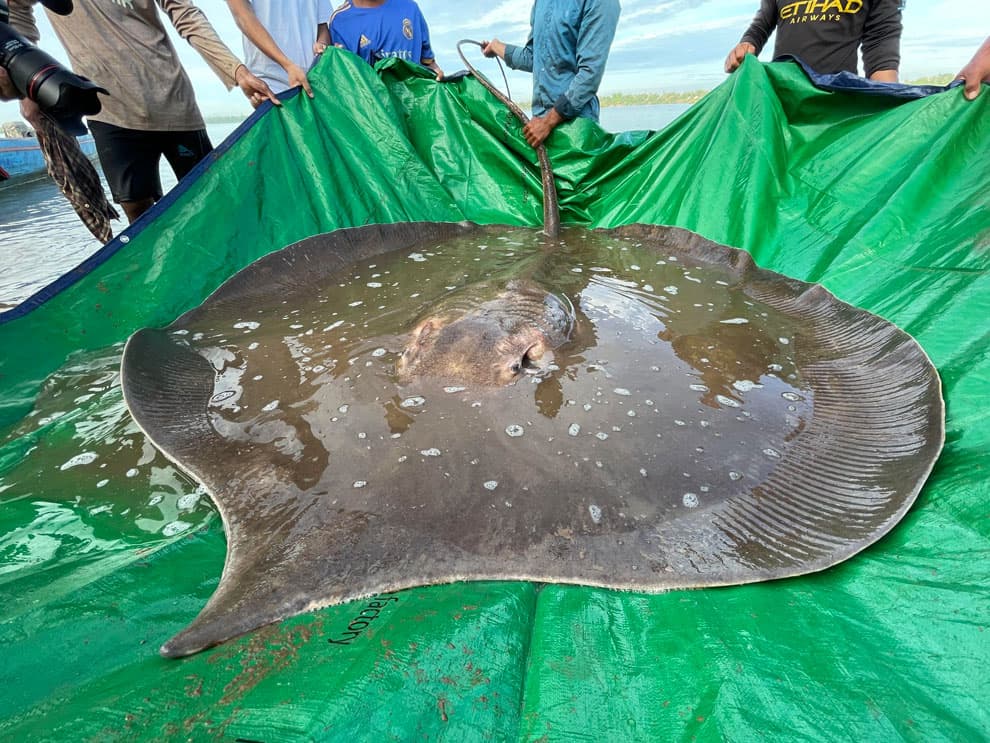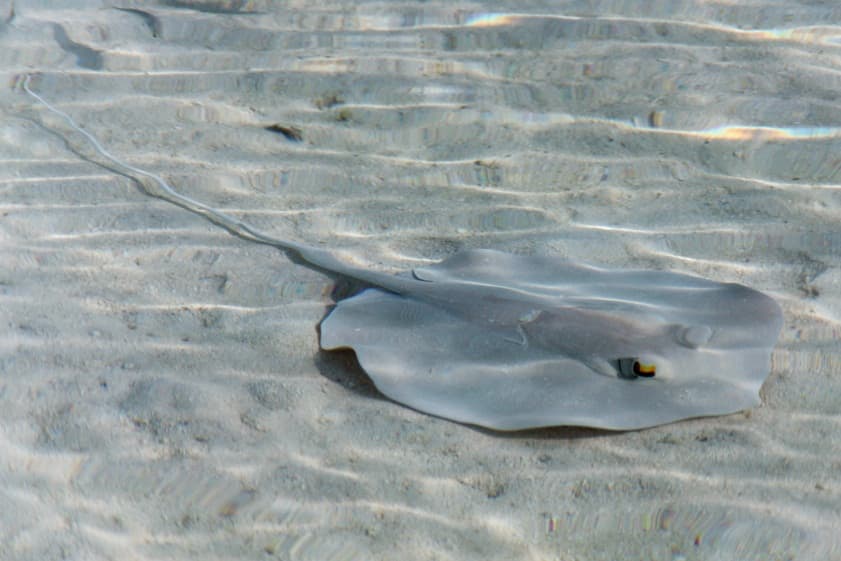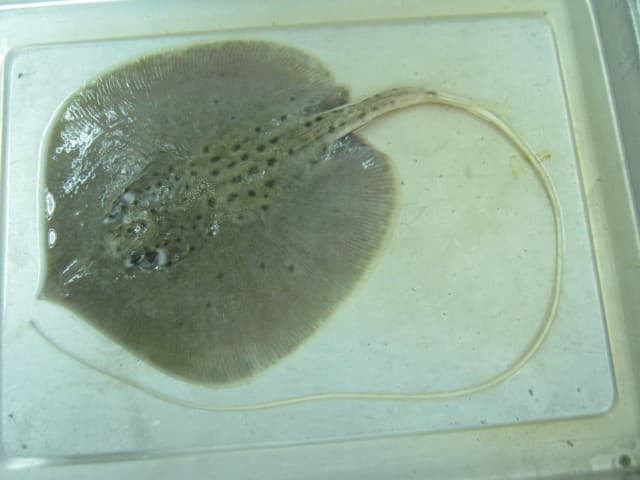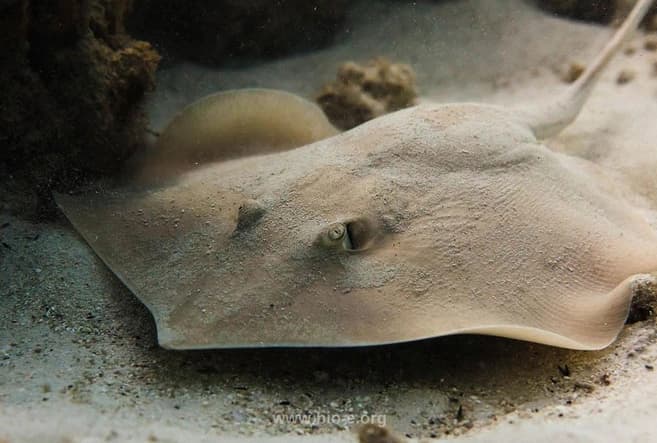Do you know that rays are the closest relatives to sharks? There are 5 ray species in Cambodia, some belong to the freshwater domain but others inhabit saltwater. Some species are very abundant but we do have the endangered ones that we don’t touch as well. Feel free to look at the small list of ray species in Cambodia below, they are very fascinating creatures.
Giant Freshwater Stingray (ត្រីបបែលយក្ស)

Scientific Name: Urogymnus Polylepis
The giant freshwater stingray aka giant freshwater whipray actually recognized by the Guinness World Record as the world’s largest freshwater fish. In 2023, the largest giant freshwater stingray ever caught was 300 kilograms with a length of 4 meters from snout to tail. A giant freshwater stingray is brown to gray in color, and it is wide and flat in form. It has grayish-brown color above with white color below while the underside of the fins have dark bands on their posterior margins. This fish has small eyes and a tiny mouth on the bottom of its head.
Giant freshwater stingrays are native to Southeast Asia, mainly in the river systems in Cambodia, Indonesia, Malaysia, and Thailand. Usually, these bottom dwellers bury themselves in sandy or silty river bottoms, leaving the spiracles visible for breathing. They inhabit muddy or sandy areas, and they prey on crustaceans, invertebrates, mollusks, and small fishes. They use the electroreceptive sensing organs around their mouth to detect prey. One of the most distinctive features of this freshwater fish is its long whip-like tail. Stingrays don’t really attack humans but the sharp barb on the base of their tails is something else. It is large and sharp enough to penetrate human skin and bone just like how an arrow works. Despite the fact that rays are docile, it is best to stay away from their tails because the barb also contains toxins.
Threats
This ray species is currently endangered due to the development of the Mekong River. One of the main threats are major hydropower dams that alter the river’s natural flow. Along with that, these past few years, the low river levels have been exacerbated due to dry-season droughts which affects that habitats too. Not to mention habitat degradation due to deforestation and land development along with overfishing, their population is not doing well at all. Back in 2016, an ethanol plant discharged cyanide-containing waste on the Mae Klong River in Thailand and killed at least 70 giant stingrays. And people in Thailand still target them for the burgeoning aquarium trade even if it is illegal to fish for stingrays.
Marbled Freshwater Whip Ray (ត្រីបបែលក្រឡា)

Scientific Name: Fluvitrygon Oxyrhynchus
A marbled freshwater whip ray has an oval pectoral fin disc with an elongated and pointy snout. Just like other rays out there, this one also has a very long whip-like tail but without fin folds. The attractive part about this whip ray is the numerous heart-shaped dermal denticles and tubercles on its upper surface. The contrast between the denticles and the reticulated pattern of brown blotches resembles marbles; hence the name. It can grow up to around 36 centimeters, excluding the tail which is 3 times the body.
This beautiful ray species is native to several freshwater rivers in Southeast Asia including Cambodia, Indonesia, Thailand, and Vietnam. As bottom dwellers, they are fond of sandy substrate where they can bury themselves. Where they live, these rays feed on benthic organisms like small crustaceans and mollusks. Unfortunately, it is now considered Endangered on the IUCN Red List due to fishing, habitat degradation, habitat fragmentation, and habitat loss.
Mekong Stingray (ត្រីបបែល)
Scientific Name: Dasyatis Laosensis
As a new whiptail stingray species from the Mekong River, there is not a lot of information about the Mekong stingray. It is actually the first endemic freshwater member of the genus Dasyatis in Southeast Asia. A Mekong stingray has a bright orange ventral surface, and it can grow up to 62 centimeters long. This ray is found in the Mekong River, mostly in Cambodia, Laos, Thailand, and Vietnam. On top of the small population, this ray is also endangered as a result of fishing pressure and habitat loss.
Scaly Whipray (ត្រីបបែលមាន់)

Scientific Name: Brevitrygon Imbricata
Medium in size, scaly whipray has a width of up to 22 centimeters and they can reach 65 centimeters in total. The habitat of this ray species is in the tropical Indo-West Pacific Oceans, ranging from the Red Sea to Indonesia. They live in inshore coastal waters, usually in estuarine habitats but they migrate between saltwater and freshwater.
White-Edge Freshwater Whip Ray (ត្រីបបែលស)

Scientific Name: Fluvitrygon Signifer
Here is one of the rarest ray species in the family, and it is one of a kind. You can easily recognize a white-edge freshwater whip ray by its sharply delineated white band around the margin of its brown disc. Its long oval pectoral fin disc can grow up to 60 centimeters across while its whip-like tail is very long. The tail is around 3.5 times as long as the disc, and it has 2 stinging spines on top. This whip ray has two long tail spines that are potentially dangerous to humans. These stings can inflict excruciating wounds that can be fatal, we have every reason to stay away from all rays’ tails.
White-edge freshwater whip ray is native to 4 river systems in Southeast Asia where they inhabit sandy habitats in fresh water. They are found in the Indo-Malay Archipelago, Peninsula Borneo and Malaysia, Sumatra, Thailand, and some parts in Cambodia. As bottom-dwellers, they feed on invertebrates like crustaceans and insect larvae. Despite the white range, this ray species is listed as endangered on the IUCN Red List due to various reasons. Some major threats include fishing, habitat degradation, habitat fragmentation, and habitat loss. People catch them using bottom-set lines, fish traps, and spears, and sell them for aquarium trade and meat. Meanwhile, dam construction, logging, and pollution have affect their habitat greatly.
Related Post: Largetooth Sawfish Facts
